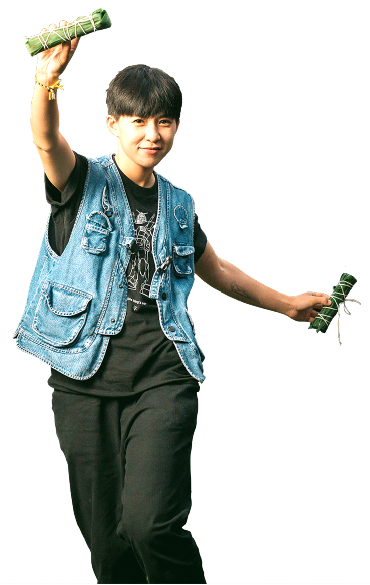How does it feel to spend three days in the slate house?

It’s generally very comfortable to stay in the slate house, not too cold and not too hot. But for a concrete house, you have to consider the layout if you want to make it comfortable. In the city, people think about building the maximum number of house units on a patch of land, but here, you have to consider typhoons and earthquakes. The purpose of buildings alone is really different. One is for safety and adapting to the environment; the other is for convenience.
There’s a lot of wisdom to the stone slab house , like the grooves cut into the walls. Smoke from firewood inside the house really can drift through the crevices and get outside. It’s truly amazing to create such a comfortable space built out of locally sourced materials.

What impressed you about the protocols, taboos, and myths about the family house?

Like on the first night, we almost committed a faux pas by sleeping with our feet facing outside. I was really surprised. This is just the opposite direction from what we normally sleep in. But when in the community, we respect the customs here. Another example is I finally got to see a section of landslide in person. Imagine the feeling if a cluster of stone slab houses was once there. It’s really different from learning history or geography in class. You really need to come to this place to understand what the textbooks are talking about.
Myths are strangers for us living on the plain but they're within reach in daily life for the indigenous people. If I didn’t visit here, I wouldn't have felt so close to myths. Looking at photos of ruins shared by Mani, I was thinking what it would be like if a myth became real. I grew up in a Taoist family, and Taoist stories don't have much connection with us mortals. The stories are about gods and spirits after all. Compared to indigenous peoples, their ancestral spirits, stories about growing millet have much more of a connection to modern life, reminding them what things to follow in daily life.
After these three days, how would you describe your new indigenous friends?
 The indigenous friends I met during the past few days are a group of people who get to know their homeland and take it to heart, and introduce their history to more people to keep their culture alive and remembered. Obviously, you can do your own thing in modern life and don’t need to worry much about it. But still Mani is willing to take up his family’s role as community leader, fulfill the mission traditional society has given to him, and devote himself to the people. It’s admirable from a modern perspective.
The indigenous friends I met during the past few days are a group of people who get to know their homeland and take it to heart, and introduce their history to more people to keep their culture alive and remembered. Obviously, you can do your own thing in modern life and don’t need to worry much about it. But still Mani is willing to take up his family’s role as community leader, fulfill the mission traditional society has given to him, and devote himself to the people. It’s admirable from a modern perspective.

I was surprised and thrilled to get a Paiwan name straight from A-Hui’s mouth (it’s Cangkim). With the prayer led by the owner of the stone slab house, elder Mai, I realized this trip had come to an end.
Because the industrial road was opened, Payuwan Community is just a one-hour drive from Kaohsiung. I slept through the entire road trip. When I got out of the car, the smoke from the wood fire in my eyes awoke my spirit. Mani has us stride over the fire and step on silver grass to rid ourselves of bad luck from outside the community. Getting the smoke on our clothes let ancestors familiarize themselves with us outsiders. I was trembling, fearing that I might disturb the ancestors. But the tension gradually eased with Mani’s good sense of humor.
The first thing after we arrived at Payuwan was eating. I was immediately captured by Mani and her family’s mastery of cooking. With the teachers guiding us, I tried my hand at making Paiwan delicacies like cinavu and qavai which looked like meatballs. I also tried making pinuljacengan and stir-frying a fish for the first time. I was all thumbs, but I did get a sense of achievement when everyone said it was “yummy!” Pacak shared his passion, which is pretty much professional, horticulture. He let me, a plant killer, bring home a staghorn fern mounted on a board. Eve taught me how to knit a four-strand braid used in their clothes. Probably because I enjoy focusing on things in front of me, and my mind won’t wander, I was fascinated making the braids and made many braids at one go. Now even eight-strand braiding is no problem for me. All these daily tasks take time and patience!
A small adventure with hunters was what I was anticipating the most, but it was also the most uneasy part of the trip. I’m the kind of person who will do all the preparation possible before hiking, but this time, in the rain at night, on an unknown road, I didn't know where to go or when to stop. Later, the hunters told us that a hunting trip usually takes a patient walk of five or six hours. That’s when I realized I’d never really slowed down to feel what the mountains and forest have to offer.
When I see animal bones during a hike, I don’t dare to take a second look. But in the community elementary school, I touched the head bone of a wild boar and stared like a biologist at the dried maggots in its eye sockets. Downstream, there are ruins of stone slab houses. The Paiwan have a tradition of burying the deceased inside the house. So when I helped clean the family house, I didn’t dare speak for fear of breaking some taboo. In the community leader’s house, I was very careful not to make any improper movements. Hearing Mani share Payuwan myths and culture, the importance of his personal identity and his mission, I felt old images were rerunning in front of me. Suddenly, I felt history was getting closer to me and I was getting closer to myself too.
This three-day trip has been so rewarding that I can’t put it into words. For the first time, a typhoon struck when I was in the mountains and I feel blessed to have survived the night. Like, when I was about to leave Payuwan, I got the new name Cangkim and a new life. All of this happened before I turn 30! I’m a lucky guy. Thank you Payuwan!
2022.08.30





